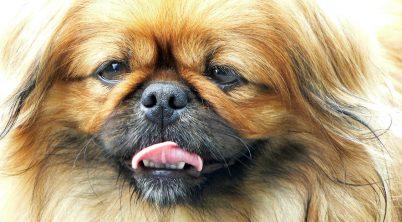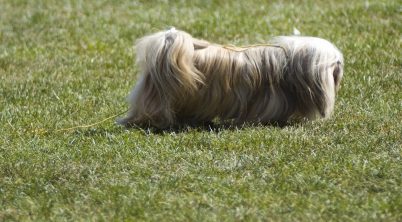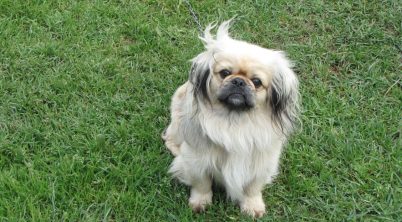Pekingese dogs are known for their distinctive flat faces and lion-like mane, which make them a popular and recognizable toy breed. However, this unique physical trait also predisposes them to a variety of breathing difficulties, commonly referred to as “breathing attacks.” Breathing difficulties in Pekingese can manifest as episodes of distress, where the dog may struggle to breathe effectively, often due to a narrowed airway which is characteristic of brachycephalic breeds.
Genetic predisposition plays a crucial role in the respiratory health of Pekingese. Their brachycephalic (short-nosed) skull shape can lead to Brachycephalic Airway Obstruction Syndrome (BAOS), a condition that can cause breathing attacks. The structure of their respiratory system, which includes narrowed nostrils, an elongated soft palate, and a constricted windpipe, can severely impact their ability to breathe, especially during exercise or stress.
When a Pekingese suffers a breathing attack, it can be a distressing experience for both the dog and the owner. Recognizing the signs of respiratory distress is key to managing these episodes. Symptoms may include snoring, wheezing, coughing, and a clear struggle to catch their breath. Understanding and responding to these episodes appropriately can improve the quality of life for these small dogs and is an essential aspect of responsible Pekingese ownership.
Table of Contents
Understanding Pekingese Breathing Structure
The Pekingese breed is predisposed to specific respiratory issues due to its distinct facial structure. Recognizing the unique aspects of their anatomy is crucial for identifying and managing their breathing problems.
Brachycephalic Characteristics
The term brachycephalic refers to breeds with a flat face and a shortened skull shape. Pekingese dogs exemplify this trait, which includes a significantly shortened upper jaw and nose. Although distinctive and often considered appealing, these characteristics can lead to difficulties in breathing. The compressed skeletal structures result in less space for the respiratory passages, leading to noisy breathing and potential upper airway obstruction.
- Nasal structure: Compromised due to short nostrils, causing increased resistance to airflow.
- Soft palate: The soft palate may be relatively elongated compared to the shortened skull, often extending into the airway and partly obstructing it.
Anatomical Abnormalities
Anatomical irregularities in Pekingese can exacerbate respiratory issues. A physical examination may reveal these abnormalities, which contribute to their breathing complications:
- Elongated soft palate: Can obstruct the airway, resulting in snorting or gagging during excitement or exercise.
- Upper airway: May present with obstruction because of the anatomy inherent to their brachycephalic nature, disrupting normal airflow and leading to difficulties in breathing.
To ensure a Pekingese’s wellbeing, awareness of these structural implications is necessary, and veterinary attention may be required to manage symptoms related to their unique anatomy.
Common Breathing Problems and Symptoms
Pekingese dogs are prone to several breathing issues primarily due to their brachycephalic (short-snouted) structure. These issues can manifest various symptoms including difficulty with breathing, coughing, and decreased tolerance for exercise.
Respiratory Distress
Respiratory distress in Pekingese is often characterized by rapid breathing, panting, and struggling for air. They may exhibit signs of stress when breathing, such as restlessness or a widened stance with the neck extended forward. Laryngeal collapse, a secondary condition, can occur, leading to severe respiratory compromise that requires immediate veterinary attention.
Obesity and Breathing Issues
Obesity exacerbates breathing problems in Pekingese by adding extra stress on the respiratory system. An overweight Pekingese may show symptoms like labored breathing, snoring, and an increased effort to breathe when at rest. This additional weight can also press on the trachea, worsening any existing conditions like tracheal collapse.
Exercising Challenges
Due to their compromised airways, Pekingese dogs can face exercise intolerance. Symptoms that may occur during physical activity include coughing, gagging, and a reluctance to exercise. It’s not uncommon to observe a Pekingese taking frequent breaks or preferring shorter, less strenuous walks to mitigate the effects of exertion on breathing.
Diagnosing Breathing Issues in Pekingese
Diagnosing breathing issues in Pekingese involves a systematic approach starting with a physical exam, followed by advanced diagnostic techniques if necessary. These steps are critical to identify the root causes of respiratory problems in this brachycephalic breed.
Physical Exam Procedures
During the initial physical examination, the veterinarian will inspect the Pekingese’s nostrils, assessing for stenotic nares, a common condition where the nostrils are narrow, restricting airflow. The vet will also look for signs of distress, such as wheezing or labored breathing, and listen to the dog’s breath sounds with a stethoscope.
Advanced Diagnostic Methods
If the physical exam indicates potential issues, further diagnostic methods are employed. Radiographs (x-rays) can reveal internal abnormalities in the chest and respiratory tract, while endoscopy allows for a closer look at the upper airways. Through endoscopy, the vet examines the nasopharyngeal turbinates, structures in the nose that can be malformed in brachycephalic dogs, contributing to breathing difficulties.
Treatment Options and Management
Pekingese dogs with breathing difficulties can benefit from various treatment options and management strategies aimed at improving their quality of life. These can range from non-invasive techniques to surgical interventions, each tailored to the dog’s specific health issues.
Non-Surgical Interventions
Non-surgical interventions are often considered as the first line of treatment for breathing difficulties in Pekingese dogs. These can include:
- Oxygen therapy: Delivering supplemental oxygen via masks or flow-by can help Pekingese suffering from acute breathing attacks.
- Medications: Prescription medications such as corticosteroids or other anti-inflammatory drugs may be administered to reduce airway inflammation and ease breathing.
- Weight management: Ensuring the dog maintains a healthy weight is crucial as obesity can exacerbate respiratory difficulties.
Surgical Alternatives
In cases where non-surgical interventions do not provide adequate relief, surgical procedures may be recommended:
- Surgical procedures: Procedures such as stenotic nares correction, elongated soft palate resection, or laryngeal saccule removal may be necessary to clear the airway obstructions.
- Postoperative care: Careful monitoring and follow-up appointments are essential after surgery to ensure a successful outcome and to manage any potential complications.
Each treatment and management strategy is chosen with the aim of enhancing the Pekingese’s respiratory function and overall well-being.
Living with a Pekingese: Prevention and Care

Managing a Pekingese’s health involves understanding their unique needs and potential health challenges. Consistent care and prevention can significantly enhance their quality of life.
Maintaining a Healthy Lifestyle
Exercise: Regular, gentle exercise helps Pekingese maintain a healthy weight, which is crucial in preventing obesity—a common issue that exacerbates breathing difficulties. Short walks in cool weather can help, but owners should monitor their dogs to prevent overheating.
Diet: Feeding a balanced diet tailored to their specific needs is important. Portion control is key to avoiding unnecessary weight gain.
Environment: A stress-free environment is beneficial for Pekingese, as stress can impact their breathing. Keeping them cool and comfortable, especially during hot weather, reduces the risk of overheating and subsequent respiratory distress.
Allergens: Owners should be mindful of allergens that may trigger respiratory issues. Ensuring a clean living space free of dust and smoke can help prevent allergic reactions that may lead to breathing difficulties.
Understanding Potential Complications
Brachycephalic Syndrome: Pekingese are prone to Brachycephalic Airway Syndrome, a structural condition causing narrowed airways which can lead to serious complications if not managed properly.
Heart Disease: Heart health is important for these dogs. Because of their structure and predisposition to being overweight, routine veterinary check-ups are crucial to detect and manage any potential heart conditions.
Eye Problems: Due to their facial structure, Pekingese are also at risk for a variety of eye issues. Regular cleanings and veterinary eye exams can help catch and treat these problems before they worsen.
Prevention of Pneumonia: Being vigilant about respiratory infections can prevent the development of pneumonia, a condition to which brachycephalic dogs are susceptible. At the first sign of coughing or gagging, consulting a veterinarian is essential.
* Banner by Jimmy Sledge, cropped | Some rights reserved








